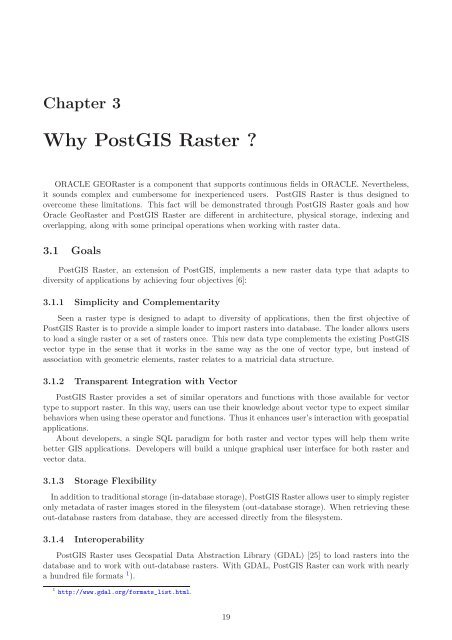PostGIS Raster : Extending PostgreSQL for The Support of ... - CoDE
PostGIS Raster : Extending PostgreSQL for The Support of ... - CoDE
PostGIS Raster : Extending PostgreSQL for The Support of ... - CoDE
You also want an ePaper? Increase the reach of your titles
YUMPU automatically turns print PDFs into web optimized ePapers that Google loves.
Chapter 3<br />
Why <strong>PostGIS</strong> <strong>Raster</strong> ?<br />
ORACLE GEO<strong>Raster</strong> is a component that supports continuous fields in ORACLE. Nevertheless,<br />
it sounds complex and cumbersome <strong>for</strong> inexperienced users. <strong>PostGIS</strong> <strong>Raster</strong> is thus designed to<br />
overcome these limitations. This fact will be demonstrated through <strong>PostGIS</strong> <strong>Raster</strong> goals and how<br />
Oracle Geo<strong>Raster</strong> and <strong>PostGIS</strong> <strong>Raster</strong> are different in architecture, physical storage, indexing and<br />
overlapping, along with some principal operations when working with raster data.<br />
3.1 Goals<br />
<strong>PostGIS</strong> <strong>Raster</strong>, an extension <strong>of</strong> <strong>PostGIS</strong>, implements a new raster data type that adapts to<br />
diversity <strong>of</strong> applications by achieving four objectives [6]:<br />
3.1.1 Simplicity and Complementarity<br />
Seen a raster type is designed to adapt to diversity <strong>of</strong> applications, then the first objective <strong>of</strong><br />
<strong>PostGIS</strong> <strong>Raster</strong> is to provide a simple loader to import rasters into database. <strong>The</strong> loader allows users<br />
to load a single raster or a set <strong>of</strong> rasters once. This new data type complements the existing <strong>PostGIS</strong><br />
vector type in the sense that it works in the same way as the one <strong>of</strong> vector type, but instead <strong>of</strong><br />
association with geometric elements, raster relates to a matricial data structure.<br />
3.1.2 Transparent Integration with Vector<br />
<strong>PostGIS</strong> <strong>Raster</strong> provides a set <strong>of</strong> similar operators and functions with those available <strong>for</strong> vector<br />
type to support raster. In this way, users can use their knowledge about vector type to expect similar<br />
behaviors when using these operator and functions. Thus it enhances user’s interaction with geospatial<br />
applications.<br />
About developers, a single SQL paradigm <strong>for</strong> both raster and vector types will help them write<br />
better GIS applications. Developers will build a unique graphical user interface <strong>for</strong> both raster and<br />
vector data.<br />
3.1.3 Storage Flexibility<br />
In addition to traditional storage (in-database storage), <strong>PostGIS</strong> <strong>Raster</strong> allows user to simply register<br />
only metadata <strong>of</strong> raster images stored in the filesystem (out-database storage). When retrieving these<br />
out-database rasters from database, they are accessed directly from the filesystem.<br />
3.1.4 Interoperability<br />
<strong>PostGIS</strong> <strong>Raster</strong> uses Geospatial Data Abstraction Library (GDAL) [25] to load rasters into the<br />
database and to work with out-database rasters. With GDAL, <strong>PostGIS</strong> <strong>Raster</strong> can work with nearly<br />
a hundred file <strong>for</strong>mats 1 ).<br />
1 http://www.gdal.org/<strong>for</strong>mats_list.html.<br />
19
















